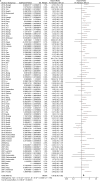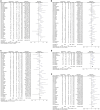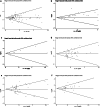Prognostic role of glycolysis for cancer outcome: evidence from 86 studies
- PMID: 30825027
- PMCID: PMC11810312
- DOI: 10.1007/s00432-019-02847-w
Prognostic role of glycolysis for cancer outcome: evidence from 86 studies
Abstract
Objective: The abnormal expression of the key enzymes in glycolytic pathways, including glucose transporter-1, glucose transporter-3, hexokinase-II, lactate dehydrogenase 5, pyruvate kinase M2, glucose-6-phosphate dehydrogenase, transketolase-like protein 1 and pyruvate dehydrogenase kinase-1 was reported to be associated with poor prognosis of various cancers. However, the association remains controversial. The objective of this study was to investigate the prognostic significance of glycolysis-related proteins.
Materials and methods: We searched MEDLINE, EMBASE, Cochrane Database of Systematic Reviews, Cochrane Central Register of Controlled Trials, using Pubmed and Ovid as search engines and Google Scholar from inception to April 2017. Eighty-six studies with 12,002 patients were included in the study.
Results: Our pooled results identified that glycolysis-related proteins in cancers were associated with shorter overall survival of colorectal cancer (HR 2.33, 95% CI 1.38-3.93, P = 0.002), gastric cancer (HR 1.55, 95% CI 1.31-1.82, P < 0.001), cancer of gallbladder or bile duct (HR 2.16, 95% CI 1.70-2.75, P < 0.001), oral cancer (HR 2.07, 95% CI 1.32-3.25, P < 0.001), esophageal cancer (HR 1.66, 95% CI 1.25-2.21, P = 0.01), hepatocellular carcinoma (HR 2.04, 95% CI 1.64-2.54, P < 0.001), pancreatic cancer (HR 1.72, 95% CI 1.39-2.13, P < 0.001), breast cancer(HR 1.67, 95% CI 1.34-2.08, P < 0.001), and nasopharyngeal carcinoma (HR 3.59, 95% CI 1.75-7.36, P < 0.001). No association was found for lung cancer, ovarian cancer or melanoma. The key glycolytic transcriptional regulators (HIF-1α, p53) were analyzed in parallel to the glycolysis-related proteins, and the pooled results identified that high-level expression of HIF-1α was significantly associated with shorter overall survival (HR 0.57, 95% CI 0.42-0.79, P < 0.001) Furthermore, glycolysis-related proteins linked with poor differentiated tumors (OR 1.81, 95% CI 1.46-2.25, P < 0.001), positive lymph node metastasis (OR 2.73, 95% CI 2.16-3.46, P < 0.001), positive vascular invasion (OR 2.05, 95% CI 1.37-3.07, P < 0.001), large tumor size (OR 2.06, 95% CI 1.80-2.37, P < 0.001), advanced tumor stage (OR 1.58, 95% CI 1.19-2.09, P < 0.001), and deeper invasion (OR 2.37, 95% CI 1.93-2.91, P < 0.001).
Conclusion: Glycolytic transcriptional regulators and glycolysis-related proteins in cancers were significantly associated with poor prognosis, suggesting glycolytic status may be potentially valuable prognostic biomarkers for various cancers.
Keywords: Cancer; Glycolysis; Meta-analysis; Prognostic markers; Survival; Systematic review.
Conflict of interest statement
This study was funded by the above institutions and has received research grants from it. All authors declare that they have no conflict of interest.
Figures









References
-
- Andersen S, Eilertsen M, Donnem T, Al-Shibli K, Al-Saad S et al (2011) Diverging prognostic impacts of hypoxic markers according to NSCLC histology. Lung Cancer 72:294–302 - PubMed
-
- Ashrafian H (2006) Cancer’s sweet tooth: the Janus effect of glucose metabolism in tumorigenesis. Lancet 367:618–621 - PubMed
-
- Baer S, Casaubon L, Schwartz MR, Marcogliese A, Younes M (2002) Glut3 expression in biopsy specimens of laryngeal carcinoma is associated with poor survival. Laryngoscope 112:393–396 - PubMed
-
- Benesch C, Schneider C, Voelker HU, Kapp M, Caffier H et al (2010) The clinicopathological and prognostic relevance of pyruvate kinase M2 and pAkt expression in breast cancer. Anticancer Res 30:1689–1694 - PubMed
Publication types
MeSH terms
Substances
Grants and funding
- 2014A030310073/National Science Foundation of Guangdong Province, China
- 2014A020212448/Guangdong Province Public interest research and capacity ? building projects, China
- 2014A030310073/Natural Science Foundation of Guangdong Province ? Doctor Foundation
- 201510010286/Guangzhou Science and technology plan of scientific research projects, China
LinkOut - more resources
Full Text Sources
Research Materials
Miscellaneous

